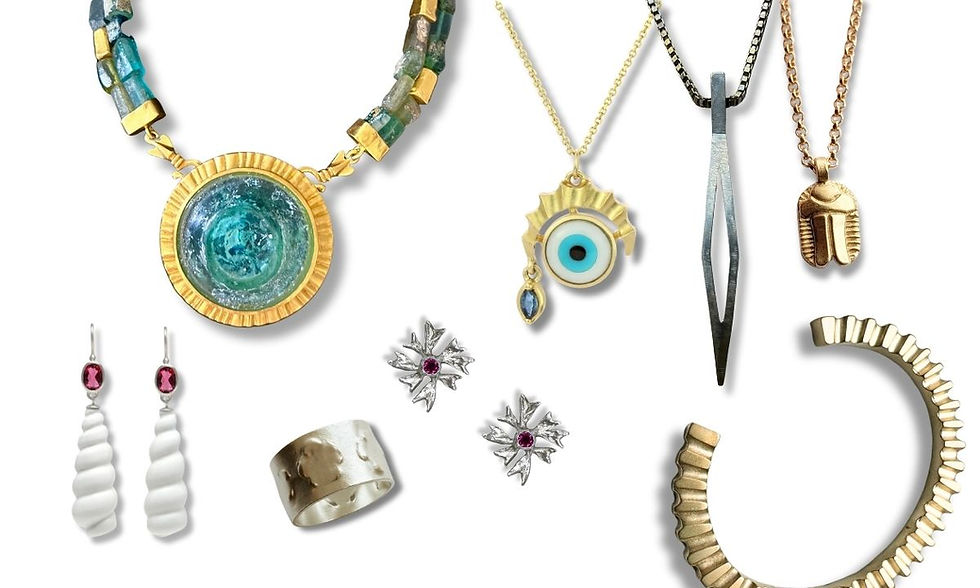The Responsible Sourcing of Colored Gemstones
- Sandrine Valentine

- Aug 1, 2022
- 3 min read
Updated: Sep 21, 2022
Written by Sandrine Valentine of Sandrine B. Jewelry
In this second installment I would like to introduce you to the responsible sourcing of colored gemstones. Colored gems are minerals prized for their beauty and rarity, often in crystalline structures and sometimes organic in origin, such as amber and jet.
Colored gemstones are extracted in large quantities in Asia, South America and Africa. One of the unique aspects of the colored gemstone market is that the particular characteristics of the jewels vary considerably by source. That provides a powerful opportunity for producers to create a strong marketing story around their specific gemstones.
Small-scale artisanal mining makes up 70–80% of the colored gemstone production.
When I started making jewelry in 2008, established jewelers entrusted me with a list of suppliers, including gemstone dealers. I made use of the list without question.
A few years ago I started thinking about my business’ core principles and values. As a human rights activist and a lover of nature, I wanted to be sure that my business is aligned with what I care about. I became acquainted with the United Nations Sustainable Goals (The Sustainable Development Goals or Global Goals are a collection of 17 interlinked goals designed to be a "blueprint to achieve a better and more sustainable future for all). I then decided to map my supply chain and reach out to my suppliers.
When looking at a stone, there are questions I would consider asking: where the stone was mined AND where it was cut and polished.
As manufacturing shut down in March 2020 and I was confined at home, I listened to webinars on colored gemstones hosted by the people I had met at the 2019 New York City Jewelry Week and in the process discovered initiatives worthy of my support. I realized that by purchasing gemstones from initiatives that partner with Artisanal and Small Scale Mining associations, I can be ensured of the provenance of the stone, empower people in the supply chain, support communities and protect the environment.
That is an investment towards a more responsible future.
Below is the list of the initiatives I have found:
1-Nineteen48 sells responsibly-sourced, fully traceable, ethical gemstones from Sri Lanka, Tanzania, Malawi and Australia. What I love about Nineteen48 is that they have calibrated gemstones, and that from their profits, they support charitable causes in the countries they work with such as Sri Lanka.
2-Moyo Gemstones is an ethical gemstone collaboration between Nineteen 48 and Anza Gems born in Tanzania. They are working with female artisanal gem miners of the Umba Valley to assure rubies, sapphires, tourmaline, garnets, citrines, and amethysts, from mine to market. The rough gemstones are brought to the United States and cut by renown gem cutters such as Beth Stier.What I love about them is that they empower women miners to work safely, mine better, improve financial security, and create stable, equitable markets for fair trade.
Moyo Rhodolite Garnet
Mined by Mariam in Tanzania
Cut by Beth Stier
I have since designed and handcrafted this beautiful one-of-a-kind ring with this ethically sourced rhodolite garnet using 18k recycled yellow gold. Learn more here.
3-Virtu Gem sources rough gemstones from Artisanal and Small Scale Mining associations in Zambia and Malawi. What I love about Virtu gem is that they offer rough gems directly to jewelers with custom gem cutting in Zambia and Malawi.
In conclusion I invite jewelers and consumers to buy gemstones from those initiatives or similar ones and make the gemstone’s journey become what you want to talk about.
Be sure to check back to learn more about the responsible sourcing of gold.
- Sandrine B.







Comments